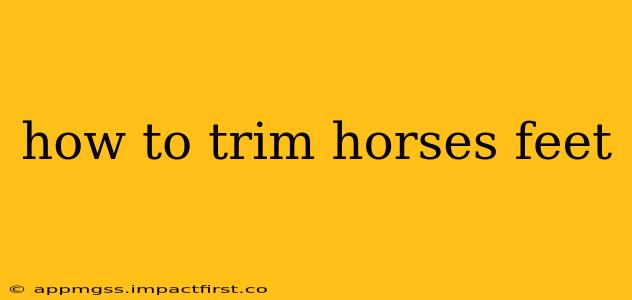Trimming a horse's feet is a crucial aspect of equine care, impacting their comfort, soundness, and overall performance. Whether you're a seasoned farrier or a horse owner just starting to learn, understanding the proper techniques is essential. This comprehensive guide will walk you through the process, addressing common questions and concerns. Disclaimer: This guide provides educational information only and should not be considered a substitute for professional farrier training. Improper trimming can cause significant harm to your horse.
What Tools Do I Need to Trim a Horse's Feet?
Before you begin, gather the necessary tools. These typically include:
- Nippers: Used for removing excess hoof wall. Different types are available, including hoof nippers with various jaw shapes and sizes.
- Rasp: For smoothing rough edges and shaping the hoof wall after using nippers.
- Hoof pick: Crucial for cleaning out dirt, debris, and manure from the hoof before trimming.
- Measuring tools: A hoof gauge can help maintain consistent hoof angles.
- Optional Tools: A hoof stand can help stabilize the horse's foot, and a hoof knife can be useful for removing excess sole material in certain situations.
How Often Should I Trim My Horse's Feet?
The frequency of hoof trimming depends on several factors, including the horse's breed, age, workload, and the rate of hoof growth. Generally, horses require trimming every 4-8 weeks. Regular trimming is vital to prevent imbalances and hoof problems. However, it's crucial to consult with a farrier to determine the appropriate trimming schedule for your horse. They can assess your horse's individual needs and recommend a personalized plan.
What is the Correct Angle for Trimming a Horse's Foot?
Achieving the correct hoof angle is paramount for maintaining soundness. The ideal angle varies depending on the horse's conformation and hoof shape. A proper trim ensures even weight distribution, preventing undue stress on the joints and ligaments. A qualified farrier possesses the expertise to assess the correct angle for your horse's feet. Attempting to estimate the angle without proper training can lead to serious consequences.
How Do I Know if My Horse Needs a Trim?
Several signs indicate your horse requires a hoof trim:
- Uneven hoof growth: Noticeably long or overgrown areas of the hoof wall.
- Overgrown heels: Heels that extend beyond the toe, altering the hoof's balance.
- Chipped or cracked hoof wall: These imperfections can lead to lameness and infection if left untreated.
- Signs of lameness: Your horse may exhibit limping or reluctance to move.
- Abnormal hoof wear: Excessive wear on one particular area of the hoof.
Always consult a farrier if you notice any of these signs. They can diagnose the issue and recommend appropriate treatment.
Can I Trim My Horse's Feet Myself?
While you might be tempted to trim your horse's feet yourself to save money, it's strongly discouraged unless you've received proper training from a qualified farrier. Improper trimming can cause pain, lameness, and long-term hoof problems. Investing in professional farrier services is a much safer and more effective approach.
What are the potential consequences of improper hoof trimming?
Improper hoof trimming can result in several serious issues, including:
- Lameness: Uneven weight distribution causes pain and discomfort.
- Hoof deformities: Long-term structural damage to the hoof.
- Increased susceptibility to injury: Weak or improperly trimmed hooves are more prone to cracks, chips, and abscesses.
- Infections: Open wounds from improper trimming can become infected.
The cost of correcting improper trimming can far exceed the cost of professional farrier services.
What if my horse is resisting a hoof trim?
Horses may resist hoof trims due to fear, past negative experiences, or discomfort. Patience, positive reinforcement, and desensitization techniques are crucial in these cases. A qualified farrier will know how to safely handle your horse and ensure a positive trimming experience.
This comprehensive guide emphasizes the importance of professional farrier care. While this information provides a general understanding of hoof trimming, it is absolutely crucial to consult with a qualified farrier for all your horse's hoof care needs. Their expertise ensures the health, comfort, and soundness of your equine companion.
